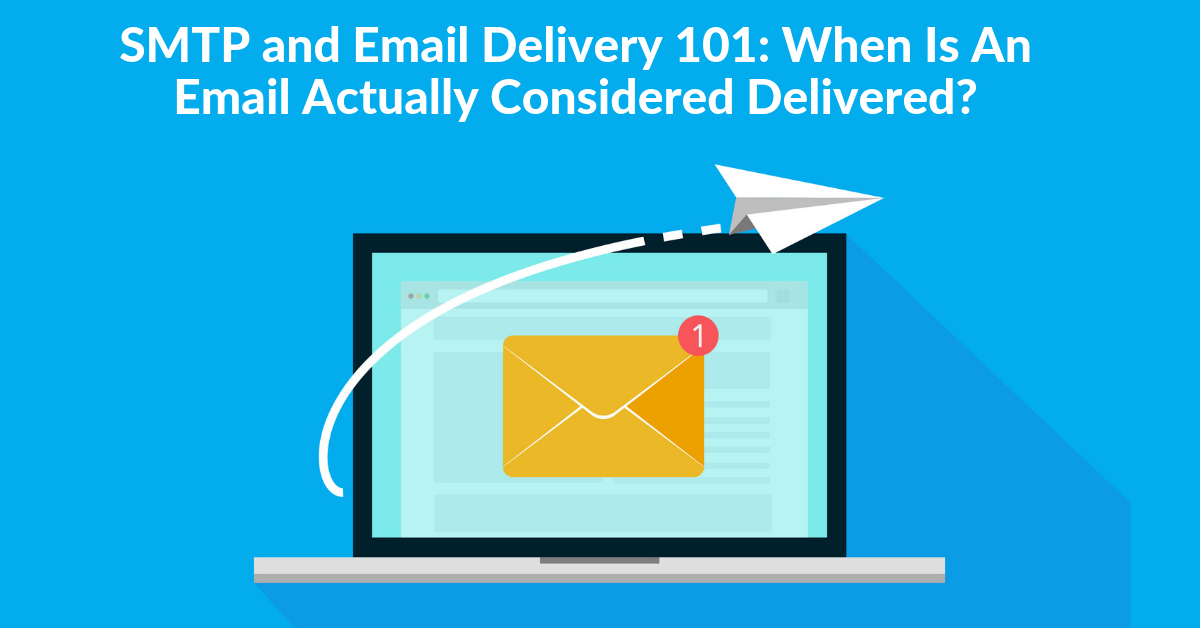
Have you ever wondered about SMTP email delivery and what it actually means for an email to be considered delivered?
For example:
- Is an email delivered when it reaches the inbox? or
- Is an email delivered when it is opened and read?
This post delves into the details of SMTP email delivery — and explains exactly how email delivery works, and what makes an email actually considered “delivered”.
SMTP Email Delivery Is Just One Part of the Puzzle
SMTP email delivery, or sending email via a Simple Mail Transfer Protocol is the email standard, and is the universal method of getting an email into a mail server. However, there are additional factors surrounding email delivery that an SMTP relay server doesn’t necessarily provide. This includes things like deliverability, sender reputation, authentication, tracking, and more.
Simply put, even if you are using the most robust SMTP server, your email may not necessarily be delivered.
This brings us to a big question when thinking about SMTP and email delivery:
What does it even mean for an email to be considered “delivered” in the first place?
To answer this question, let’s start by discussing what email delivery means.
Email Delivery vs Email Deliverability
It’s easy to confuse “email delivery” with “email deliverability.” So, let’s start with some simple definitions to help explain the differences between the two.
What Is Email Delivery?
Standard Email Delivery is when an email is sent to a receiving mail server over SMTP. The mail server then chooses whether or not it would like to accept the message. This happens before the message is placed in the inbox or spam folder. Therefore, “delivery” refers to whether or not the receiving email server accepted the message.
What Is Email Deliverability?
Email Deliverability is a term referring to what happens after the message is accepted by the receiving email server. For example, an email’s deliverability status is dependent upon whether it’s placed in the inbox, spam folder, or somewhere else. Email deliverability is more related to inbox placement. If you’re having trouble reaching the inbox, then here are some best practices to help you improve email deliverability.
Why is Delivery Important?
Email delivery is extremely important, especially when sending business critical email like password resets, status notifications, and time sensitive alerts. This is because if the emails land in the spam folder, then they aren’t useful to your customers or you.
Now that you have a basic understanding of what delivery means, let’s explore when an email is actually considered ‘delivered.’
How Does Email Delivery Work & When Is a Message Considered Delivered? (3 Common Answers)
If you ask someone when an email is considered ‘delivered,’ don’t be surprised if you receive a number of different responses. Here are three of the most common answers to this question.
An email is considered delivered when:
- 1) The email is accepted by the receiving mail server: In this case, the message leaves the sender’s mail client and is successfully received by the mail server. However, there’s still more work to be done on behalf of the receiving mail server to determine how to properly handle the message. This scenario is equivalent to sending a package to a mailroom at an office building. Even if someone signs off on the package, it doesn’t mean that the intended recipient received the package.
- 2) The message is placed in the appropriate mailbox of the receiving mail server: In this situation, the message was not only received by the mail server, but the message was also placed in the appropriate mailbox. Going back to our mailroom example, this is similar to sending a package to a mailroom, having someone sign off on the package, and then delivering the package to the intended recipient. However, this case does not account for whether or not the recipient opened the message.
- 3) The recipient opens and reads the message: Finally, this case takes the answer for ‘when is an email considered delivered?’ to the extreme by saying that the recipient actually opened and read the message.
Since the meaning of “delivered” varies depending upon the situation, context, and the email service provider (ESP), all three answers are correct. However, from a technical perspective, there is only one correct answer.
250 OK Status: The Technically Correct Answer for Whether or Not Your Email Has Been Delivered
Technically speaking, a message is considered delivered when your mail server receives a “250 OK” SMTP response at the end of an SMTP transmission.
What Does the “250 OK” Status Mean?
A server response of “250 OK” indicates that the SMTP communication was successful and it’s issued in response to every accepted command — likely 4 to 6 times per message. For more information about SMTP Response Codes, check out the list of 21 SMTP Response Codes That You Need To Know.
As a sender, you will almost never notice the “250 OK” response, because this code happens in the background after an SMTP email delivery transmission. Therefore, it’s safe to consider a message delivered when it arrives in the target mailbox.A good email delivery company or SMTP relay service, will provide you with failed and delivered message reporting, so you can easily check your email deliverability, without having to dig into your logs for a “250 OK” response code.

That wraps up our blog post on SMTP email delivery! If you have any questions surrounding email delivery/deliverability, contact us online today!







